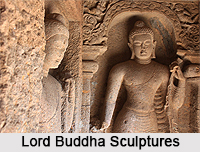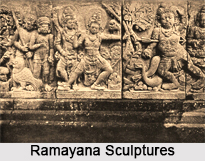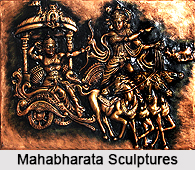 Features of Gupta sculptures revolved around the subjects inspired by the marvellous sculptures which had been created during the period of the Kushanas. It is also believed that the distinctive style of Gupta sculptures have also evolved from those influenced by Gandhara and Mathura schools. This was the age when Buddhism rose to prominence. The sculptural style of the Guptas marks an amalgamation of grace and repose, which is quite evident from the Buddha statue at Sarnath.
Features of Gupta sculptures revolved around the subjects inspired by the marvellous sculptures which had been created during the period of the Kushanas. It is also believed that the distinctive style of Gupta sculptures have also evolved from those influenced by Gandhara and Mathura schools. This was the age when Buddhism rose to prominence. The sculptural style of the Guptas marks an amalgamation of grace and repose, which is quite evident from the Buddha statue at Sarnath.
One of the main features of the Gupta sculptures is the balance that has been achieved by the artist between the beautiful poses and the spiritual expressions. The Gupta sculptures presented the human figures at their best. Whether they were spiritual or mythical, the human figures displayed elements of robustness and lively. Apart from the human and religious sculptures, terracotta sculpture and decorative sculptures also have well defined human forms. The other recurrent features included thick floral sculptures, carved scrolls, animal figures and others. Apart from the rock cut sculptures the Gupta artists were equally adept in working on metals. The iron pillars at Delhi are an instance for this kind of sculpture. The predominant style which was followed by the artists was "cire perdue". In this process the copper statues were cast on a large scale. A copper image of Lord Buddha cast in Nalanda, which was 80 feet high is worth mentioning. 
The art and architecture of the Gupta period have been forever engraved on the walls of the Ajanta caves. Apart from the sculptures these caves are also famous for their wall paintings. Speaking about the religious sculptures, those deities were carved out of stone which the human eyes have never before beheld. The descriptions of such Gods and Goddesses were heard of but they existed only in the imagination. It is always a challenge to present gods and goddesses in a human form as the sanctity of these deities had to be kept intact. The expressions on the faces of such sculptures were devoid of any material pleasure. The expressions on these idols were undisturbed by the worldly affairs. The apparels were presented by the series of folds carved on the figure of the deities yet the elegant forms were not hidden under these clothes. Such sculpted figures are widely found in Mathura. This rock architecture in Mathura is quite well known.
The sculptures created during the Gupta period were perfect, without any blemishes. In fact according to historical evidences the artists followed the science of `chitra.` The immediate events inspired the artists to a large extent, for example, the seated Buddha at Sarnath delivering a sermon. Another feature of Gupta sculpture is the cave that was carved within the hills. The caves were the perfect places for the deities to reside as there is tranquillity within these structures. For instance, Elephanta Caves also exhibited spectacular Gupta sculpture.
The religious tolerance of the Gupta kings is evident from the fact that there were Hindu and Jain sculptures as well. The Hindu sculptures at Udaigiri were made out of wood. One of the most outstanding sculptures at Udaigiri Caves is the `Varaha` avatar of Lord Vishnu. It is represented with a head of a boar (varaha) and a human (nar) body. This image has its roots in the Indian mythological tales. This bas relief measures 22 feet by 12 feet. The entire mythical event is presented in details in Udaigiri. These caves are also famous for the iconography of Mahishasuramardini and one-faced linga or Ekmukhalinga. The Gupta sculptures also drew heavily from the epics, Ramayana and Mahabharata. Snakes were an essential feature of Gupta sculpture, particularly during the 5th century. One will notice the presence of some serpent hoods emerging from `naginis` and `nagarajas`, from the upper part of a pillar in the area of Firozpur.
It is represented with a head of a boar (varaha) and a human (nar) body. This image has its roots in the Indian mythological tales. This bas relief measures 22 feet by 12 feet. The entire mythical event is presented in details in Udaigiri. These caves are also famous for the iconography of Mahishasuramardini and one-faced linga or Ekmukhalinga. The Gupta sculptures also drew heavily from the epics, Ramayana and Mahabharata. Snakes were an essential feature of Gupta sculpture, particularly during the 5th century. One will notice the presence of some serpent hoods emerging from `naginis` and `nagarajas`, from the upper part of a pillar in the area of Firozpur.
Other dominant architectures from the Gupta Empire included the rock cut temples, chaityas, stupas and others. During this age the square `Garbhagriha` emerged with pillars in the temples. The temple walls were ornamented with the sculptures of celestial beings, animal forms, deities and their consorts, couples and the everyday themes included dancers, musicians, military processions, scenes from royal court, apsaras and others. Eroticism was also a popular feature of Gupta sculptures. The interiors of Vaishnavite Tigawa Temple at Jabalpur, Dasavatara Temple at Deogarh and Bhitargaon Temple all of which are located in the central Indian state of Madhya Pradesh are excellent specimens of the sculpture prevalent during the Gupta age.



